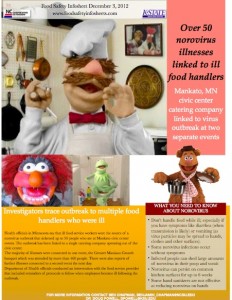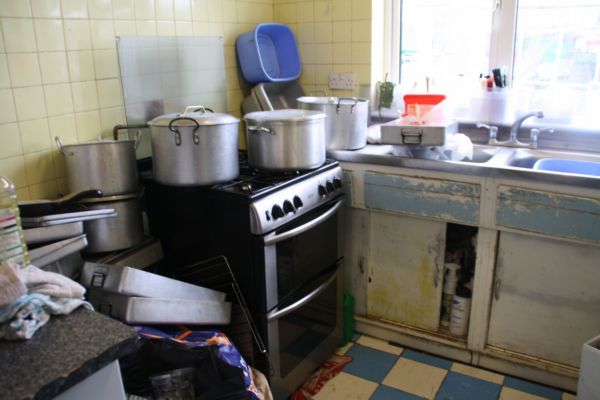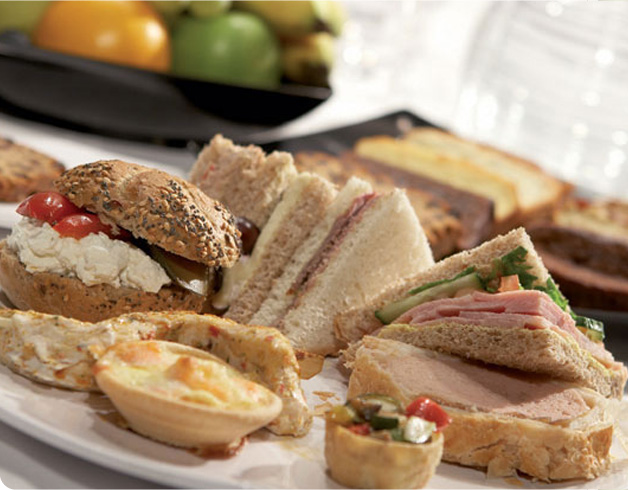In a triumph of food porn over food safety, an investigation into an outbreak of salmonellosis in the summer of 2010 after a wedding party in Bavaria, Germany that sickened at least 52 people failed to pinpoint a specific food source but did uncover a number of disturbing food safety practices – such as adding rose petals to food and no temperature checks — again linked to an unlicensed caterer.
German researchers report in Eurosurveillance this week that in the summer of 2010, a local health office in northern Bavaria, Germany, was informed that approximately half of the 110 guests of a wedding that had taken place the preceding weekend had contracted gastroenteritis. At the wedding party, soup and a late-lunch buffet (served from 3 p.m.) and a cold dinner buffet (served .jpg) from 10 p.m.) had been provided by an out-of-town caterer. In addition, a wedding cake made by a local bakery and a number of cakes and desserts contributed by different wedding guests were served by the catering staff at 20.00. The food served at the wedding was suspected to be the source of the outbreak. Initial laboratory results of stool samples of some guests who became ill indicated Salmonella enterica subsp. enterica serovar Enteritidis (S. Enteritidis) as the causative pathogen.
from 10 p.m.) had been provided by an out-of-town caterer. In addition, a wedding cake made by a local bakery and a number of cakes and desserts contributed by different wedding guests were served by the catering staff at 20.00. The food served at the wedding was suspected to be the source of the outbreak. Initial laboratory results of stool samples of some guests who became ill indicated Salmonella enterica subsp. enterica serovar Enteritidis (S. Enteritidis) as the causative pathogen.
According to the caterer, only the meat dishes were prepared at the caterer’s facilities in advance. All sauces, antipasti and salads were made from commercially produced ingredients and were prepared at the wedding party venue. Food items that required cooling were transported in cooling boxes and stored in cooling units at the venue. At the venue, the lunch buffet was set up for six hours, between 2 p.m. (the buffet was set up one hour before it was available to guests) and 8 p.m. No checks were carried out of holding temperatures of the warm or cold dishes. Salads and other cold dishes were not cooled during this period. Photographs of the buffet showed that a number of the cold dishes were decorated with non-edible flowers (such as roses), which were inserted into the food. The flowers had been purchased at a wholesale retailer. Cakes supplied by a number of wedding guests were stored without cooling until they were served at 20:00. The dishes of the dinner buffet were not cooled. They were first served at 10 p.m. It is unclear for how long the dishes of the dinner buffet were served; however, it is known that the catering personnel departed at 00.30.
Inspection of the catering facilities and interview of the catering staff revealed a number of shortcomings contravening European food hygiene regulations. The facilities used by the caterer were not registered with the local authorities. There were no records of the required staff training on food hygiene. No temperature controls of cooling devices or transport boxes were carried out, nor were temperatures monitored during preparation or serving of warm dishes. There were no records of HACCP concept planning or implementation. The company was banned from catering until proof of changes in their practices had been provided to the local authorities.
The cohort study showed that a variety of dishes were associated with a significantly increased risk of infection: in particular consumption of a group of lunch dishes containing mayonnaise was associated with a high relative risk. Despite the constraint of a two-week delay between the wedding party and the questionnaires being sent out, participants appeared to recollect well which dishes they had consumed.
The isolation of S. Enteritidis from two of the food samples at the wedding party was judged to show that the food served posed a health risk, as all the food items were ready for consumption without requiring further preparation or heating. The isolation of indistinguishable Salmonella strains  from the food samples as well as from stool samples of respondents and catering personnel supported the hypothesis that the outbreak was foodborne.
from the food samples as well as from stool samples of respondents and catering personnel supported the hypothesis that the outbreak was foodborne.
There are several possibilities for the source of the Salmonella contamination in this outbreak. Mayonnaise is a well-recognized vehicle of contamination when raw egg is used as an ingredient. However, in this outbreak all cold dishes and salads were made from commercially prepared ingredients. As commercially produced mayonnaise and sauces are conventionally based on pasteurized ingredients, it is unlikely that they would be the primary source of contamination. Commercial mayonnaise by itself is also not suitable for Salmonella propagation, due to its low pH adjusted by acetic acid. However, addition of mayonnaise to other salad ingredients may alter the overall acetic acid concentration of the mixture, thus providing a suitable base for proliferation once the pathogen has been introduced by secondary contamination.
The environmental investigation revealed a number of infringements of food safety regulations, including a lack of staff training and the absence of records of a food safety concept according to the HACCP principles. Lack of temperature controls for food storage and transport as well as prolonged presentation of buffet dishes at room temperature provided ideal conditions for pathogen proliferation, regardless of the primary source of contamination.
While they do not replace official controls, the HACCP principles are central to the European concept of food safety by helping food business operators to attain a high standard of food safety. Successful implementation of procedures based on the HACCP principles requires the full cooperation and commitment of food business employees. Adequate training of personnel is central to achieving this goal.
The outbreak investigated in this study demonstrates the consequences of lack of staff training and the failure to identify hazards to food safety, as well as failure to implement control measures to mitigate such hazards. The use of flowers as food decoration demonstrated insufficient understanding of the potential for contamination through products that are not intended for food production and therefore not subject to food hygiene regulations.
Intelligently implemented food hygiene concepts not only benefit the consumer but are also very much in the interest of the food business operator, whose business can be threatened by food-borne outbreaks. Initial hygiene and food safety training for food business operators should therefore also explain microbiological principles underlying food safety practices in order to equip the businesses with the required background knowledge and motivation to design and implement an intelligent food safety/HACCP concept, including the consideration and identification of potential sources of contamination. Explicit mention of the dangers of the use of non-edible flowers for decoration should be considered in guides to good practice, which are a valuable instrument to aid food business operators with compliance with food hygiene rules and with the application of the HACCP principles.
The complete paper is available at http://www.eurosurveillance.org/ViewArticle.aspx?ArticleId=20076.
 Lana Plank of Lana Plank Catering was fined $500.
Lana Plank of Lana Plank Catering was fined $500.








 below 8C but was at 18C.
below 8C but was at 18C..jpg) from 10 p.m.) had been provided by an out-of-town caterer. In addition, a wedding cake made by a local bakery and a number of cakes and desserts contributed by different wedding guests were served by the catering staff at 20.00. The food served at the wedding was suspected to be the source of the outbreak. Initial laboratory results of stool samples of some guests who became ill indicated Salmonella enterica subsp. enterica serovar Enteritidis (S. Enteritidis) as the causative pathogen.
from 10 p.m.) had been provided by an out-of-town caterer. In addition, a wedding cake made by a local bakery and a number of cakes and desserts contributed by different wedding guests were served by the catering staff at 20.00. The food served at the wedding was suspected to be the source of the outbreak. Initial laboratory results of stool samples of some guests who became ill indicated Salmonella enterica subsp. enterica serovar Enteritidis (S. Enteritidis) as the causative pathogen.  from the food samples as well as from stool samples of respondents and catering personnel supported the hypothesis that the outbreak was foodborne.
from the food samples as well as from stool samples of respondents and catering personnel supported the hypothesis that the outbreak was foodborne. .jpg) events at an
events at an .jpg) contaminated on a farm with E. coli O157:H7 and makes people barf after eating at a catered event, a restaurant, or a home, how is that scored? And does it matter?
contaminated on a farm with E. coli O157:H7 and makes people barf after eating at a catered event, a restaurant, or a home, how is that scored? And does it matter? linked to food after more than 40 people fell ill following an April 28 funeral and reception for a leading Auckland musician.
linked to food after more than 40 people fell ill following an April 28 funeral and reception for a leading Auckland musician. Earlier this month it was reported
Earlier this month it was reported